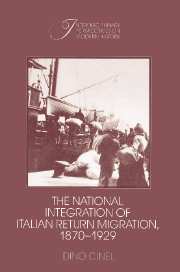Book contents
- Frontmatter
- Contents
- Acknowledgments
- Introduction: Emigration and the process of national integration
- 1 The difficult task of national integration
- 2 A blueprint for change
- 3 The southern ethos
- 4 The national debate
- 5 Return migration
- 6 American remittances
- 7 Investing American savings
- 8 Regional differences
- 9 Return and retirement
- Conclusion: National integration and return migration
- Notes
- Index
1 - The difficult task of national integration
Published online by Cambridge University Press: 03 December 2009
- Frontmatter
- Contents
- Acknowledgments
- Introduction: Emigration and the process of national integration
- 1 The difficult task of national integration
- 2 A blueprint for change
- 3 The southern ethos
- 4 The national debate
- 5 Return migration
- 6 American remittances
- 7 Investing American savings
- 8 Regional differences
- 9 Return and retirement
- Conclusion: National integration and return migration
- Notes
- Index
Summary
The goal of national integration
From 1848 to 1870 the populations of the Italian peninsula experienced the Risorgimento Nazionale, the political integration of the Kingdom of the Two Sicilies (Italian south and the island of Sicily), the Papal States (central Italy), the Grand Duchy of Tuscany (the region around Florence), and the Austro-Hungarian Lombardo-Veneto (the northeast) with a handful of minor states into the Kingdom of Italy. The leadership of the movement was provided by the Kingdom of Sardinia (Piedmont and the island of Sardinia) and its king, Victor Emmanuel II. The capital, originally in Turin, moved south to Florence, and finally to Rome, when in 1870 Italian troops forced the pope to surrender his state and his sovereignty over the city.
The political integration of Italy mirrored other processes of national integrations occurring in the major countries of the Western world in the nineteenth century. Regional cultures and economies were progressively absorbed into national cultures and economies. The several independent German states, for instance, found their economic, political and, to a degree, cultural integration into a unified Germany. The American Civil War too was fought over the issue of regional (state) versus national (federal) integration. France and Great Britain, of course, had been politically unified for centuries. Both nations, however, embraced major programs of economic and political integration of their still heterogeneous populations and economies.
For educated people in the nineteenth century, national integration seemed an eminently desirable goal The architects of the Italian process envisioned only positive results. Social reform would follow political unification.
- Type
- Chapter
- Information
- Publisher: Cambridge University PressPrint publication year: 1991

